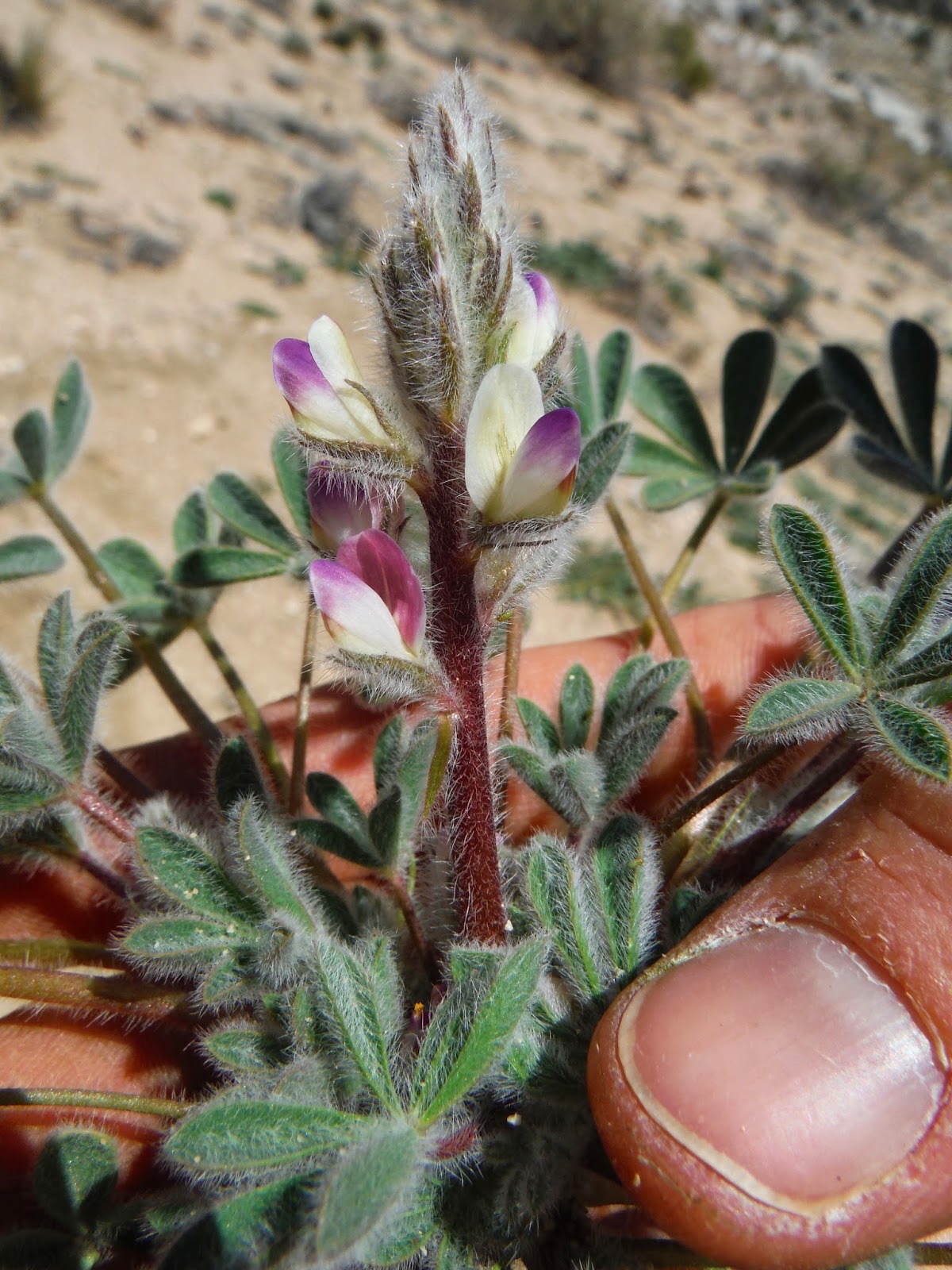After the storms had passed, I decided to wait a couple of weeks before returning to the Kiavah Wilderness. I was pretty sure the Kiavah would be bone dry, just like last year. I did not get my hopes up high because last year was so barren and just plain sad. All I could think about was why I did not decide to do a flora of an area that gets tons of rain. But that's the thing about Southern California. You never know where the rain is going to fall or if it will.
Fortunately, I was able to visit the high desert near Pearblossom this past weekend, March 9th, 2014. Oh my! Certain areas in the desert were just spectacular! We found
Muilla coronata in flower! This was the sign I had been waiting for. This was the sign that screamed, "Get out there! Go to the Kiavah ASAP!"
 |
| Fellow classmates smelling desert annuals near Pearblossom, California |
On Monday, I decided that I needed to see the Scodie Mountains. Could it be green? Could that 2.13 inches of rain really be enough? I was sure that it wasn't and that it would be a bust. I thought hard and long about who I could ask to assist me in the field. Tommy Stoughton, a fellow classmate, had been asking me about visiting the Wilderness. And then I had my answer. After a few quick email exchanges between the two of us, I had my first field assistant lined up and ready to go into the field with me on Tuesday.
Day 1
Tuesday, March 11, 2014
Tommy and I left from Rancho Santa Ana Botanic Garden, around 11:30 a.m. We headed up the 395 with ease.
It was a great day to go to the field. We parked on the side of Highway 178, geared up and started our hike straight up the slopes into the Sequoia National Forest Boundary. Our destination was Pinyon Peak. We were going to backpack in and botanize the flat dry meadow at the top.
At about sunset and after climbing over 1000 vertical feet for three hours, we decided to set up camp, eat dinner and call it a night.
 |
| Setting up camp. Owens Peak in the background. |
Day 2
Wednesday, March 12, 2014
From camp we loaded daypacks with collecting gear and the essentials and headed over to the dry meadow. It took about an hour or so to get to. As we were hiking we noted tons and tons of
Allium leaves, but no flowers in sight. At one point all of the
Allium leaves looked like grass blades. It was spectacular. I cannot wait to see which species it could be.
 |
| Tons of Allium sp. leaves littering the ground. Photo by T. Stoughton |
As we approached the meadow we did not see anything in flower. That is when we realized that we were not going to collect much on this trip. When we got to the meadow it was extremely dry! I was a little disappointed because I was sure we would get to see some water in it.
 |
| Dry as a bone meadow. Carex sp. popping up. Pinus Jeffreyii bordering the meadow. |
We headed over to the area I like to call "the Badlands" and we did collect an
Antennaria dimorpha. It was so cute and little.
Lewisia rediviva was scattered all over this site but still in a very immature state. I hope all of them decide to flower. It will be a spectacular display if they all do.
 |
| Little Lewisia rediviva leaves. Photo: T. Stoughton |
After exploring the area for a bit and finishing our lunch we decided to head back down to camp. We made great observational data and I now have my sites set on certain taxa the next time I return to this spot.
We reached base camp, packed up our gear and headed out. As we were hiking out we noticed that a couple of things were in bloom but near the lower elevations. We picked up the few things we found and finally reached the car.
 |
| Phacelia fremontii Photo by T. Stoughton |
We decided that we could stop along the highway and collect in the BLM area since we had a little time before sunset. We found a turn out, parked, got out of the car and then it happened. TONS and TONS of annuals! All over! This was what I was looking for and I only had less than 45 minute to scour the desert floor in sandals. Tommy and I hunted like mad botanists in pursuit of something great. We must have looked crazy. One would scream a plant name, "
BOECHERA!" and the other collector would yell, "
CASTELLEJA!" It was a collecting frenzy.
 |
| Collecting desert annuals. Lots of green going on |
 |
| Pressing our bounty |
Compared to last year this was a gold mine. Last year was just a sad miserable dry year. This year is starting off with a bloom! I plan on revisiting the Wilderness this weekend. I cannot wait to get back out there!
 |
| Tommy and Boechera pulchra in a Joshua tree woodland. |
Overall it was a successful trip. It was a great kick-off for the start of the field season. Tommy was a great field assistant. It was a real pleasure to collect with him. He really knows his plants. I'm so glad he was was able to join me. If you are in need of an awesome botanist to join you in the field be sure to take Tommy with you. You'll be glad you did.









